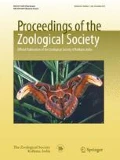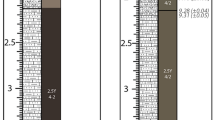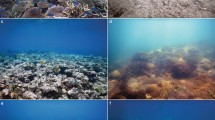Abstract
Great Nicobar Island is the southernmost island of Andaman and Nicobar group of islands and largest island of Nicobar group included in UNESCO-MAB-Network of biosphere reserve. The island is inhabited by a total of 173 species of scleractinian corals from 6 different study areas among the 577 species reported from entire Andaman and Nicobar Islands. The Shannon–Weiner diversity index ranged from 2.84 to 4.45 while the Simpson’s density index ranges from 0.93 to 0.99. Among the study areas, it was seen that the Laxman Beach is most diverse in comparison with the other 5 areas. Presence of 29.98 % scleractinian coral species in Great Nicobar Island denotes the sense of ecological attributes behind the sustainable support towards the coral settlement, growth and development.







Similar content being viewed by others
References
Berger, W.H., and F.L. Parker. 1970. Diversity of planktonic Foramenifera in deep sea sediments. Science 168: 1345–1347.
Bradbury, R.H., R.E. Reichelt, D.L. Meyer, and R.A. Birtles. 1986. Patterns in the distribution of the crinoid community at Davies Reef on the central Great Barrier Reef. Coral Reefs 5: 189–196.
Done, T.J., R.A. Kenchinton, and L.D. Zell. 1982. Rapid, large area, reef resource surveys using a manta board. Proceedings of the Fourth International Coral Reef Symposium, Manila 2: 597–600.
Endean, R., and W. Stablum. 1973. A study of some aspects of the crown of thorns starfish (A. planci) infestations of reefs of Australia’s Great Barrier Reef. Atoll Research Bulletin 167: 1–60.
English, S., C. Wilkinson, and V. Baker. 1997. Survey manual for tropical marine resources, 2nd ed, 390 p. Townsville: Australian Institute of Marine Science.
Fisher, R. A. 1925, 1946. Statistical methods for research workers. Edinburgh: Oliver and Boyd (Page numbers refer to the 10 edition, 1946).
Kenchinton, R.A. 1984. Large area surveys of coral reefs. UNESCO Reports in Marine Science 21: 92–103.
Kleypas, J. 1977. Modeled estimates of global reef habitat and carbonate production since last glacial maximum. Palaeoecanography 12: 535–545.
Loya, Y. 1978. Plotless and transect methods. In Monographs on oceanic methodology. coral reefs: research methods, vol. 5, ed. D.R. Stoddart, and R.E. Johannes, 197–218. Paris: UNESCO Press.
Mann, K.H. 1982. Ecology of coastal waters: A systems approach. Studies in Ecology 8: 160–182.
Margalef, R. 1968. Perspective in ecological theory, 112 p. Chicago: University of Chicago Press.
Menhinick, E.F. 1964. A comparison of some species diversity indices applied to samples of field insects. Ecology 45: 858–862.
Pielou, E.C. 1969. An introduction to mathematical ecology. New York: Wiley.
Raghunathan, C., C. Sivaperuman, and K. Venkataraman, eds. 2011. Diversity of corals and its associated fauna in Great Nicobar Island, Andaman and Nicobar Islands. In Recent Advances in Biodiversity of India, 211–236. Published by the Director, Zoological Survey of India.
Shannon, C.E., and W. Weiner. 1964. The mathematical theory of communication. Urbana, IL: The Uni. of Illinois press.
Simpson, E.H. 1949. Measurement of diversity. Nature 163: 688. doi:10.1038/163688a0.
Smith, S.V. 1978. Coral reef area and the contribution of reefs to processes and resources of the world oceans. Nature 273: 225–226.
Tamal Mondal, C. Raghunathan, and Ramakrishna. 2011. New findings of four scleractinian corals from great nicobar island. Proceedings of 98th Indian Science Congress, Part II, Section XII: New Biology 88.
Tamal Mondal, C. Raghunathan, and K. Venkataraman. 2012a. Diversity and distribution of corals in Andaman and Nicobar Islands. Journal of Coastal Environment 3(2): 101–110.
Tamal Mondal, C. Raghunathan, and K. Venkataraman. 2012b. New distribution record of eight scleractinian corals to Indian water from Andaman and Nicobar Islands. Advances in Biological Research 6(3): 110–120. doi:10.5829/idosi.abr.2012.6.3.63236.
Tamal Mondal, C. Raghunathan, and K. Venkataraman. 2013. Status of scleractinian diversity at Nancowry Group of Islands. Middle-East Journal of Scientific Research 14(5): 587–597. doi:10.5829/idosi.mejsr.2013.14.5.71212.
Tikadar, B.K., and A.K. Das. 1985. Glimpses of animal life of Andaman and Nicobar Islands, 1–170. Calcutta: Zoological Survey of India.
UNESCO. 2013. www.unesco.org.
Venkataraman, K. and Ch. Satyanarayana. 2012. Coral identification manual, 1–136. Port Blair: Zoological Survey of India.
Venkataraman, K., R. Rajan, Ch. Satyanarayan, C. Raghunathan, and C. Venkatraman. 2012. Marine ecosystems and marine protected areas of India, 1–296. Kolkata: Zoological Survey of India.
Venkataraman, K., Satyanarayan, Ch., Alfred, J.R.B. and J. Wolstenholme. 2003. Handbook on Hard Corals of India, 1–266. Kolkata: Zoological Survey of India.
Veron, J.E.N., and M. Pichon. 1976. Scleractinia of Eastern Australia, Part I, 86 p. Townsville: Australian Institute of Marine Science.
Veron, J.E.N., M. Pichon, and M. Wijsman-Best. 1976. Scleractinia of Eastern Australia, Part II, 233 p. Townsville: Australian Institute of Marine Science.
Veron, J.E.N., and M. Pichon. 1979. Scleractinia of Eastern Australia, Part III, 421 p. Townsville: Australian Institute of Marine Science.
Veron, J.E.N., and M. Pichon. 1982. Scleractinia of Eastern Australia, Part IV, 159 p. Townsville: Australian Institute of Marine Science.
Veron, J.E.N., and C.C. Wallace. 1984. Scleractinia of Eastern Australia, Part V, 485 p. Townsville: Australian Institute of Marine Science.
Veron, J.E.N. 2000. Corals of the World, vols. 1–3, 1410 p. Townsville: Australian Institute of Marine Science.
Wallace, C.C. 1999. Staghorn corals of the world. Melbourne: CSIRO Publications. 421 p.
Acknowledgments
Authors are grateful to the Ministry of Environment, Forests and Climate Change, Government of India for providing financial assistance to undertake the study through the projects of National Coral Reef Research Institute, Zoological Survey of India, Port Blair. The authorities of Department of Environment and Forests, Andaman and Nicobar Administration are duly acknowledged for logistic support to undertake field studies.
Author information
Authors and Affiliations
Corresponding author
Rights and permissions
About this article
Cite this article
Mondal, T., Raghunathan, C. & Venkataraman, K. Diversity of Scleractinian Corals in Great Nicobar Island, Andaman and Nicobar Islands, India. Proc Zool Soc 69, 205–216 (2016). https://doi.org/10.1007/s12595-015-0145-8
Received:
Revised:
Accepted:
Published:
Issue Date:
DOI: https://doi.org/10.1007/s12595-015-0145-8




